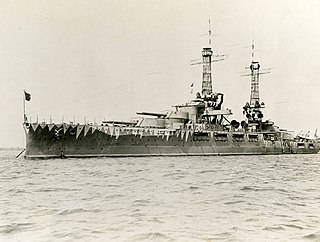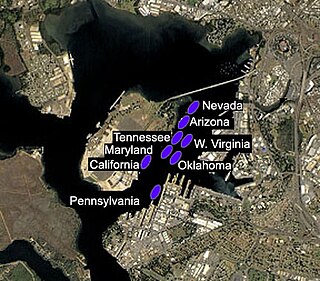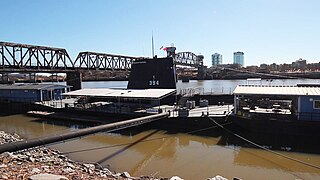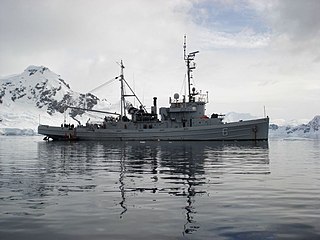
USS Arizona was a battleship built for the United States Navy in the mid-1910s. Named in honor of the 48th state, she was the second and last ship in the Pennsylvania class. After being commissioned in 1916, Arizona remained stateside during World War I but escorted President Woodrow Wilson to the subsequent Paris Peace Conference. The ship was deployed abroad again in 1919 to represent American interests during the Greco-Turkish War. Two years later, she was transferred to the Pacific Fleet, under which the ship would remain for the rest of her career.

USS Nevada (BB-36), the third United States Navy ship to be named after the 36th state, was the lead ship of the two Nevada-class battleships. Launched in 1914, Nevada was a leap forward in dreadnought technology; four of her new features would be included on almost every subsequent US battleship: triple gun turrets, oil in place of coal for fuel, geared steam turbines for greater range, and the "all or nothing" armor principle. These features made Nevada, alongside her sister ship Oklahoma, the first US Navy "standard-type" battleships.

USS New Mexico (BB-40) was a battleship in service with the United States Navy from 1918 to 1946. She was the lead ship of a class of three battleships, and the first ship to be named for the state of New Mexico. Her keel was laid down on 14 October 1915 at the New York Navy Yard, from which she was launched on 23 April 1917 and commissioned on 20 May 1918. New Mexico was the U.S. Navy's most advanced warship and its first battleship with a turbo-electric transmission, which helped her reach a maximum speed of 21 knots.

USS Oklahoma (BB-37) was a Nevada-class battleship built by the New York Shipbuilding Corporation for the United States Navy, notable for being the first American class of oil-burning dreadnoughts. Commissioned in 1916, the ship served in World War I as a part of Battleship Division Six, protecting Allied convoys on their way across the Atlantic. After the war, she served in both the United States Battle Fleet and Scouting Fleet. Oklahoma was modernized between 1927 and 1929. In 1936, she rescued American citizens and refugees from the Spanish Civil War. On returning to the West Coast in August of the same year, Oklahoma spent the rest of her service in the Pacific.

USS Utah (BB-31/AG-16) was the second and final member of the Florida class of dreadnought battleships. The first ship of the United States Navy named after the state of Utah, she had one sister ship, Florida. Utah was built by the New York Shipbuilding Corporation, laid down in March 1909 and launched in December of that year. She was completed in August 1911, and was armed with a main battery of ten 12-inch (305 mm) guns in five twin gun turrets.

Battleship Row was the grouping of seven U.S. battleships in port at Pearl Harbor, Hawaii, when the Japanese attacked on December 7, 1941. These ships bore the brunt of the Japanese assault. They were moored next to Ford Island when the attack commenced. The ships were Arizona, California, Maryland, Nevada, Oklahoma, Tennessee, and West Virginia. A repair ship, Vestal, was also present, moored next to Arizona.

The Pearl Harbor Naval Shipyard and Intermediate Maintenance Facility is a United States Navy shipyard located in Pearl Harbor, Hawaii on 148 acres. It is one of just four public shipyards operated by the United States Navy. The shipyard is physically a part of Joint Base Pearl Harbor–Hickam.

USS Medusa (AR-1) was the United States Navy's first purpose-built repair ship. She served in the U.S. Navy from 1924 to 1946.

USS Avocet (AM-19/AVP-4) was a Lapwing-class minesweeper initially acquired by the U.S. Navy for the dangerous task of removing mines from minefields laid in the water to prevent ships from passing.

The second USS Tern (AM-31) was an Lapwing-class minesweeper acquired by the U.S. Navy for the dangerous task of removing mines from minefields laid in the water to prevent ships from passing.

A Service Squadron (ServRon) was a United States Navy squadron that supported fleet combat ships and US Navy Auxiliary ships. Service Squadrons were used by the US Navy from their inception in 1943 to as late as the early 1980s. At the time of their inception during the Second World War they allowed the US Navy to operate across the vast reaches of the Pacific Ocean for extended periods of time. Service Squadrons created temporary forward bases to allow the naval squadrons to spend less time in transit and more time in the area of combat. Ulithi, a small volcanic atoll in the central Pacific, is an example of a site converted for use as a forward base of supply. Service Squadrons essentially created a major naval base near the area of operation. With naval bases like, Naval Base Ulithi, to refit, repair and resupply, many ships were able to deploy and operate in the western Pacific for a year or more without returning to a major port facility. Among the vessels operating in service squadrons were tankers, Fleet oilers, refrigerator ships, ammunition ships, supply ships, floating docks and repair ships. They provided diesel, ordnance, aviation fuel, food stuffs and all other supplies. Equally important at places like Ulithi were the portable piers and floating dry docks which allowed many ships damaged by enemy action or Pacific storms to undergo repair without having to travel the thousands of miles back to a major US naval base. Ulithi was as far forward from the US naval base at San Francisco as the San Francisco base was from London, England. To have a fully functional major port in the middle of the Pacific was a significant aid to U.S. Navy operations.

USS Nokomis (YT-142/YTB-142/YTM-142) was a Woban-class harbor tug built in Bremerton, Wash, and assigned to Pearl Harbor, Hawaii, in 1940. Nokomis was present during the Japanese attack on Pearl Harbor, 7 December 1941. She was the first vessel on scene at the USS Arizona, and was called off by the officers on deck because of the imminent explosion of the battery below deck. It then left and helped beach the USS Nevada, with Hoga (YT-146), and YT-153. The beaching of the Nevada saved Pearl Harbor's mouth from being blocked. After that the USS Nokomis fought fires and dewatered the battleship USS California, for 3 days. This effort made the California salvageable, to be recommissioned again later in the war. Nokomis was also the last vessel to move the surviving YC-699 barge prior to the Japanese attack on Pearl Harbor. Post-war she continued serving Pearl Harbor ships until she was decommissioned in May 1973, and eventually sold for "scrap" to Crowley, in San Francisco. She was renamed Sea Serpent and served many years in the San Francisco Bay as a tug and fire boat. In 1989, after the Loma Prieta earthquake in the SF Bay area, Nokomis and Hoga fought fires alongside each other again.

USS Wenonah (YT-148/YTB-148/YTM-148) was a Woban-class district harbor tug which served during World War II in California ports, and continued her service until she was struck by the Navy in 1974. On 17 August 2009, the Wenonah sank while berthed at Treasure Island, CA, and was raised by the floating crane Left Coast Lifter on 28 August 2009.

The Arkansas Inland Maritime Museum is a maritime museum located at 120 Riverfront Park Drive, North Little Rock, Arkansas which opened on May 15, 2005. The museum's collection includes artifacts from multiple vessels from the state's history, as well as two World War 2 vessels.
The Standard-type battleship was a series of thirteen battleships across five classes ordered for the United States Navy between 1911 and 1916 and commissioned between 1916 and 1923. These were considered super-dreadnoughts, with the ships of the final two classes incorporating many lessons from the Battle of Jutland.

ARA Suboficial Castillo (A-6) was an Abnaki-class tug/patrol boat of the Argentine Navy. She previously served in the United States Navy as USS Takelma (ATF-113) from 1944 to 1992. The ship was acquired by Argentina in 1993 and was in service until the 2020s. In 2022, the ship was put up for sale. Suboficial Castillo was used as support ship for both the Argentine Submarine Force and during the summer campaigns in Antarctica in the Patrulla Antártica Naval Combinada with the Chilean Navy to guarantee safety to all touristic and scientific ships that are in transit within the Antarctic Peninsula.

Naval Station Pearl Harbor is a United States naval base on the island of Oahu, Hawaii. In 2010, as part of the recommendations of the Base Realignment and Closure (BRAC) commission, the naval station was consolidated with the United States Air Force's Hickam Air Force Base to form Joint Base Pearl Harbor–Hickam. Since 1940, Pearl Harbor has been the headquarters of the United States Pacific Fleet.

Salvaged artifacts from the USS Arizona, a battleship that was catastrophically sunk during the 1941 attack on Pearl Harbor, are displayed in several locations around the United States.

Puget Sound Naval Shipyard is a large military-industrial complex located in Bremerton, Washington along the north shore of Sinclair Inlet, which opens to Puget Sound. This large shipyard is 1.5 miles (2.4 km) in length along the shore and over a half-mile in width at its greatest distance across. The shipyard has nearly 1,000 facilities such as shipfitters shops, repair shops, drydocks, piers, cranes, crane rails, railways, and tunnels. In addition to the industrial facilities, supporting structures include: residences for officers and enlisted personnel, recreation facilities, boiler, electrical substations, fuel tanks, medical facilities, and canteens. The historic district is just over a tenth of the entire shipyard, 189 acres of the shipyard's 1,347 acres. Its greatest significance was during the Second World War when it repaired large warships damaged in the Pacific theater. It was designated a National Historic Landmark District in 1992.

YFD-2 was an auxiliary floating drydock built for the United States Navy in 1901. The first parts were laid down in early 1901 at Maryland Steel Co. of Sparrows Point, Maryland. YFD-2 was the first of its kind, steel movable auxiliary floating drydock, used to raise large ships out the water for repair below the ship's waterline. YFD-2 had a 18,000 tons lifting capacity.






















